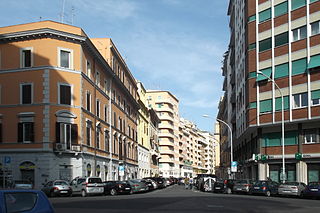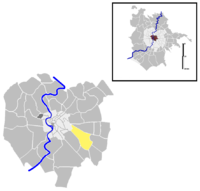Loading AI tools
Quartiere of Rome in Lazio, Italy From Wikipedia, the free encyclopedia
Tuscolano is the 8th quartiere of Rome (Italy), identified by the initials Q. VIII. The name derives from the ancient road Via Tuscolana. It belongs to the Municipio V and Municipio VII.
Q. VIII Tuscolano | |
|---|---|
Quartiere of Rome | |
 The beginning of Via Tuscolana in Piazza Sulmona | |
 Position of the quartiere within the city of Rome | |
| Country | Italy |
| Region | Lazio |
| Metropolitan City | Rome |
| Comune | Rome |
| Municipio | Municipio V Municipio VII |
| Established | 20 August 1921[1] |
| Area | |
| • Total | 2.7634 sq mi (7.1572 km2) |
| Population (2016)[2] | |
| • Total | 103,446 |
| Time zone | UTC+1 (CET) |
| • Summer (DST) | UTC+2 (CEST) |
The origins of the territory - which, as for the landscape, social and cultural aspect is now totally similar to Appio-Latino - can be dated back to the Middle Age, when the road that gave it its name, the Via Tuscolana, was first mentioned in a papal seal Honorius III issued in 1217. The road was built to link Rome with Tusculum but does not seem to have a classical origin: nothing to do with the road has the imperial mausoleum known as Monte del Grano (which was related to the nearby Roman villa called Ad Duas Lauros), nor do the columbaria of Via Pescara, which were probably built along a cross street of the Via Labicana. The first archaeological vestige that can be certainly connected to the Via Tuscolana is the Torre del Quadraro, a 12th-century guard tower.
The territory of the quartiere is crossed by five imposing aqueducts built between 144 BC and 212 AD: Aqua Marcia, Aqua Tepula and Aqua Iulia, gathered together within the same structure, Aqua Claudia and Anio Novus, as well as the Aqua Antoniniana, an offshoot of the Aqua Marcia. Up to the 1930s, the territory was also cut through by the Acqua Mariana, which is dated back to 1122 by the Liber Pontificalis: it was commissioned by Pope Callixtus II to allow the irrigation of the Ager Lateranense, the fields surrounding Saint John Lateran.
The territory of the quarter includes the urban zones 9A Tuscolano Nord, 9B Tuscolano Sud, 9C Tor Fiscale, 6C Quadraro, as well as part of the urban zones 10A Don Bosco and 10B Appio Claudio.
The most relevant roads of the quartiere are Via Tuscolana, Via Appia Nuova and Via Casilina. The nerve center of the traffic is Piazza Re di Roma (which is shared with Quartiere Appio-Latino).
Northward, Tuscolano borders with Rione Esquilino (R. XV), from which it is separated by the portion of the Aurelian Walls between Piazzale Appio and Piazzale Labicano, and with Quartiere Prenestino-Labicano (Q. VII), whose boundary is outlined by the stretch of Via Casilina between Piazzale Labicano and Via di Centocelle.
Eastward, the quarter borders with Quartiere Don Bosco (Q. XXIV), whose border is marked by Via di Centocelle and Via dell'Aeroporto. To the south-west, it borders with Quartiere Appio Claudio (Q. XXV): the boundary is delineated by the stretch of Via del Quadraro between Via Tuscolana and Via Appia Nuova.
To the south, the quarter borders with Quartiere Appio-Pignatelli (Q. XXVI), from which it is separated by the stretch of Via Appia Nuova between Via del Quadraro and Via dell'Almone.
To the west, Quartiere Tuscolano borders with Quartiere Appio-Latino (Q. IX): the boundary is marked by the stretch of Via Appia Nuova between Via dell'Almone and Piazzale Appio.
Streets and squares of Tuscolano are mostly named after Italian towns in the northern part, Roman personalities and consuls in the south-eastern part and towns of Lazio in the central part. The roads near the former Centocelle airport are named after prominent aviators. Odonyms of the quarter can be categorized as follows:



Seamless Wikipedia browsing. On steroids.
Every time you click a link to Wikipedia, Wiktionary or Wikiquote in your browser's search results, it will show the modern Wikiwand interface.
Wikiwand extension is a five stars, simple, with minimum permission required to keep your browsing private, safe and transparent.